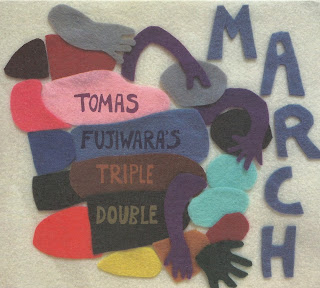It's no exaggeration to say that Tomas Fujiwara wrote the book on two guitar/two brass/two drums music. But that's directly related to the fact that there wasn't such a book written prior to Triple Double's self-titled debut in 2017. The group charted territory that explored the possible combinations of players in duos and trios with an array of sonic results.
Since that release, the band (Fujiwara and Gerald Cleaver on drums; Mary Halvorson and Brandon Seabrook on guitar; Ralph Alessi on trumpet and Taylor Ho Bynum on cornet) has grown from a first-time blend of like minds to a group that, through Fujiwara's writing, has figured out the best ways to bring those voices to together.
The music on March seems to be based as much on the written work as much as the very distinct improvisations that all the musicians will produce. "Wave Shake and Angle Bounce," to offer a good example, lets everyone cut loose at the start. Seabrook is up front, though that perspective could be all relative. The theme does sound like a march, with Halvorson bending notes while the brass blows passages behind her. Eventually the lines are again blurred between who is actually soloing or whether it's a group improvisation. Then the guitars revert to a rhythmic role, so as not to get in anyone's way.
On their debut, each guitar/horn/drum trio was split between the two channels, making it a little easier to tell who was doing what. Not so this time. Of course, it's easy to tell Halvorson's hollowbody tone and bent pitches from Seabrook's quasi-psychedelic wailing, which starts to sound like Sun Ra's electric keyboard in reverse ("The March of the Storm Before the Quiet of the Dance"). Bynum and Alessi can sometimes be more of a challenge. though Bynum is likely the gruff one of the two.
Cleaver and Fujiwara occasionally get into a friendly tussle but they also avoid excessive clatter and instead feel like one large trap kit, powering the music. While "Docile Fury Ballad" does not live up to its name until the final minutes of echo-heavy guitars, "Silhouettes In Smoke" does feel docile, with Fujiwara moving to vibes that work beautifully with layers of melody from the trumpet and cornet.
The only let down of March comes with "For Alan, Part II." Like its forerunner on the debut, the track features Fujiwara and Cleaver in a duet that pays tribute to Alan Dawson, who had been the former's teacher. Part one included audio excerpts of Dawson giving pointers to young Tomas, but Part Two is all drums. And it goes on for 17 minutes. Interesting layers of traps appear in the piece, such as when a steady pulse exerts itself and doesn't seem to be the work of either drummer. When the duo reaches a lull around the seven-minute mark, it feels like that might have been a good time to stop because the remainder lacks a strong dynamic push. "For Alan, Part II" comes at the end of the album so it doesn't disrupt the flow of a strong album.
Brandon Seabrook





No comments:
Post a Comment